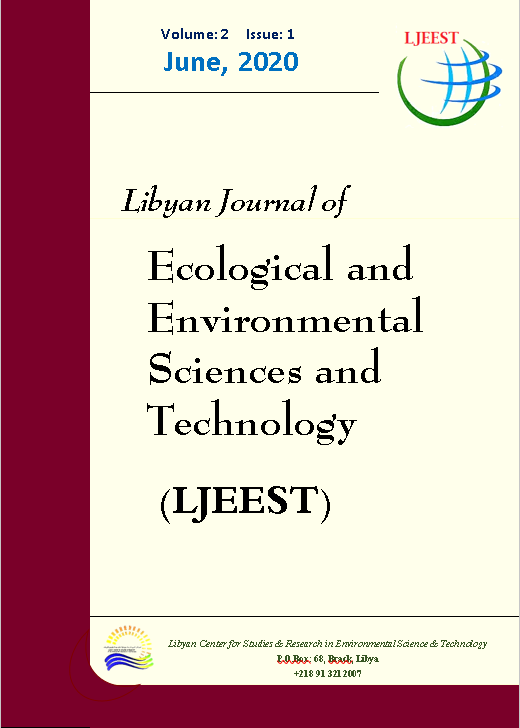Identification of Freshwater Algae from Kufrah, Libya
DOI:
https://doi.org/10.63359/05rv9m80Keywords:
freshwater algae, Cyanophyta, Chlorophyta, Bacillariophyta, EuglenophytaAbstract
The Libyan freshwater algae remains partially unexplored in term of their distribution. Many reports done on algae in south of Libya, but recently need more new reports. A survey of farms in kufra was undertaken from October 2010 to May 2011. Out of 16 sites of water bodies surveyed from different farms. Among the sampling sites there were algal blooms comprising 24 species following to 24 genera and 5 divisions were recorded. Chlorophyta, Cyanophyta, Bacillariophyta, Euglenophyta and Dinophyta. Chlorophyta was the most dominant, followed by Cyanophyta. They were observed as scums or mat on the surface of water bodies.
References
Chen, Y. Y., & Liu, Q. Q. (2014). On the horizontal distribution of algal-bloom in Chaohu Lake and its formation process. Acta Mechanica Sinica, 30(5), 656-666.
Compère, P. (1986). Algues récoltées par J. Léonard dans le désert de Libye. Bulletin du Jardin botanique national de Belgique/Bulletin van de Nationale Plantentuin van Belgie, 9-50.
Desikachary, T. V. (1959). Cyanophyta, Monograph on blue green algae. ICAR, New Delhi, India, 1-689.
Glibert, P. M., Icarus Allen, J., Artioli, Y., Beusen, A., Bouwman, L., Harle, J., ... & Holt, J. (2014). Vulnerability of coastal ecosystems to changes in harmful algal bloom distribution in response to climate change: projections based on model analysis. Global change biology, 20 (12), 3845-3858.
Guiry, M.D. (2013). Algae Base. World-wide electronic publication, National University of Ireland, Galway.
Hamida. EL. & Hanan. M. A. (2018). Collection and definition of freshwater algae in City of Shahat, Libya. Journal of Environmental Science, Toxicology and Food Technology, (12)12: 37-41
Issa, A. A., Attitalla, I. H., & El-Mesmary, H. M. 2012. A first Report of Fresh Water Algae at Suluq lake, Libya. Topclass Journal of Microbiolog, 1(1) :18-24
Khan MA. (1995). Floristic studies of Diatom communities and habitat characteristics of some inland waters in Libya. Arab Gulf J. Sci. Res., 13: 133-149.
Khan, M. A. (1989). Studies on limnobiotic conditions in a thermal spring at Tajura,(Tripoli), Libya. Acta hydrochimica et hydrobiologica, 17(4), 401-405.
Khan, M. A. (2010). Limnological research in Libya. International Journal of Ecology and Environmental Sciences, 36(1), 59-66.
Khan, M. A. (2010). Limnological research in Libya. International Journal of Ecology and Environmental Sciences, 36(1), 59-66.
Khan, M. A., & Zarmouh, M. M. (1989). Phyto‐and Zooplankton Composition and Some Ecological Observations on a Man‐made Lake in Wadi el Majanin, Libya. Acta hydrochimica et hydrobiologica, 17(5), 525-532.
Léonard, J., Misonne, X., Klerkx, J., De Heinzelin, J., Haesaerts, P., Van Noten, F., & Petiniot, R. (1969). Expédition scientifique belge dans le désert de Libye. Africa Tervuren, 15 (4):101-134.
Marchesoni, V. (1947). Flora algologica del Fezzan e della regione di Gat. Mém. Ist. Ital. Idrobiol. 3, 431-461.
Naqqiuddin, M. A., Kader, M. A. O. A., Muhamad, N., Nor, N. O., Shohaimi, S., & Zulkifly, S. (2017). Comparison of phytoplankton diversity and succession between two small man-made lakes in Serdang, Selangor. Tropical Ecology, 58(3), 485-496.
Nizamuddin, M., & Gerloff, J. (1982). Freshwater algae from Libya. Nova Hedwigia: Zeitschrift fur Kryptogamenkunde.
O’neil, J. M., Davis, T. W., Burford, M. A., & Gobler, C. J. (2012). The rise of harmful cyanobacteria blooms: the potential roles of eutrophication and climate change. Harmful algae, 14, 313-334.
Omar, M. A., Naqqiuddin, M. A., Shohaimi, S., Omar, H., & Ismail, A. (2016). Phytoplankton diversity in relation to different weather conditions in two urban made lakes. Sustainability, Agri, Food and Environmental Research, 4(1).
Omar, M. A., Azmai, M. N. A., Omar, H.,& Ismail, A. (2016). Water quality, primary productivity and carbon capture potential of microalgae in two urban manmade lakes, Selangor, Malaysia.Advances in Environmental Biology, 10(3), 10-22.
Quézel, P. (1958). Mission botanique au Tibesti. Mem,inst. Rech.sahar.4:357.
Saad, S. M. & Alsanbany M. M. (2019). Diagnosis of algae present in the concrete basins and their relationship to saturation food for some farm area Fezzan (south of Libya). Journal of Pure & Applied Sciences, 18 (3): 43- 50.
Schwabe, G. H., & Simonsen, R. (1961). Cyanophyceen und Diatomeen aus der Krateroase Wau en‐Namus (Fezzan, zentrale Sahara). Internationale Revue der gesamten Hydrobiologie und Hydrographie, 46(2), 255-268.
Downloads
Published
Issue
Section
License

This work is licensed under a Creative Commons Attribution-NonCommercial 4.0 International License.











